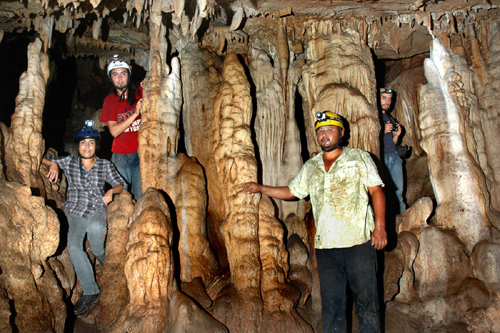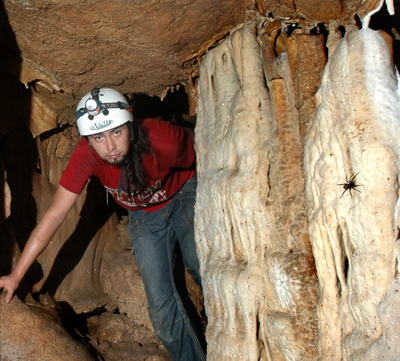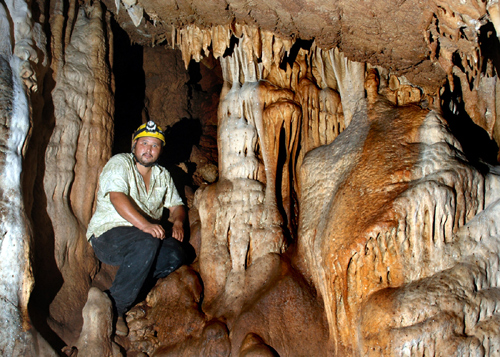|
By John Pint
 It’s 7:00 AM at Rancho El Zapote.
The air is full of early morning sounds. Loudest of all are the
roosters who live only meters from my tent and have been trying to wake
me up since 4:00 AM. Then come the chickens, a very large pig and
dozens of loudly mooing cows, one of which wears a clanking bell,
indicating that she is the leader of the herd. It’s 7:00 AM at Rancho El Zapote.
The air is full of early morning sounds. Loudest of all are the
roosters who live only meters from my tent and have been trying to wake
me up since 4:00 AM. Then come the chickens, a very large pig and
dozens of loudly mooing cows, one of which wears a clanking bell,
indicating that she is the leader of the herd.
Suddenly
I hear the
distant and repeated gurgle of a car engine which doesn’t want to
start, accompanied by incomprehensible shouts of men who, I’m sure, are
crowded around an uncooperative truck. Finally, va-room, va-room,
va-ROOOOOM! The deafening attempts to start the car go on forever and I
decide it’s time to get out of my sleeping bag and into my caving
pants. I am here with members of two caving clubs, Grupo Zotz and CEO
and today we are going to visit La Cueva de los Monos (Cave of the
Figurines), which can only be reached after a long, hard climb up a
steep mountainside above the little town of Toxin, which is located 37
kilometers northwest of Colima City, not far from Mexico’s west coast.
The cave is so named because local people claim they found artifacts
inside, or so we are told by Mexican speleologist Carlos Lazcano, who
explored the cave in 1984. Since then I don’t believe any cavers have
visited it until geologist Chris Lloyd recently relocated it and pinned
its location down by GPS.
Our group obviously considered a good breakfast the key to good caving,
so it wasn’t until 10:20 that we finally headed up a north-trending
trail which at first struck me as very friendly, after all the stories
I had been told about the previous visit to this cave. “That climb was
a killer,” said Mario Guerrero, leader of this trip and the preceding
one, “because it was the hottest week of May, which is the hottest
month of the year, and we hadn’t brought along nearly enough water.”
Now we were enjoying the relatively cool weather of November and we
gained several hundred meters of altitude in a matter of minutes. The
higher we rose, the more big, white, rocky outcrops we found along the
way. “This is beautiful karst,” said our Spanish geologist, Isidoro
Ortiz, pointing out the prickly surface, weathered by the rain,
indicating that we were inside a calcite zone where nicely decorated
caves were likely to be found.

“At this rate we’ll
reach the cave in nothing flat,” I thought, but at that very moment,
our friendly trail came to an end at the edge of a cornfield. “Chin,”
said Mario, “No sign of the trail anymore, but all we have to do is
keep going north and follow the GPS.”
Well, the cornfield into which we plunged also happened to be home to
billions of well-developed, ripe-for-traveling huizapoles (very
prickly burrs) with which we were soon covered head to foot.
At last we got through the cursed cornfield and stopped under a huge
ficus tree to pick the burrs off one another. Right next to the tree
was a pit about three meters wide and perhaps twenty deep, which we
registered for future examination. After removing a million or so huizapoles from our
clothing, we pushed our way into thick maleza (bush)
higher than our heads. “Yeow, uña de gato!” I heard someone yell up
ahead. This is cat’s claw, just about the nastiest form of thorn you
can find anywhere, as it is designed to grab you as you pass by and
then tear your skin to shreds. We now had to proceed with great caution.
It was around about this point that our guide, Noé, son of our host at
Rancho el Zapote, was forced to start swinging a machete in order to
advance, further reducing our forward speed to that of a procession of
turtles.
At last, dripping with sweat, well scratched by cat’s claw and covered
with a new set of burrs, we arrived at the cave entrance.
Here, after several minutes of rest, we donned our helmets, lights and
grungiest jackets and followed Mario to a small, A-shaped cave
entrance. He then slid down a steep slope. All I could see was his back
end, but I could hear him swearing. “¡Caray! Not even a rat could get
into this miserable little hole ¡Diablitos!” This, it turned out, was
not the cave at all, but a bit further along the same vertical wall, we
found the real entrance, right next to a huge fig tree. A crawl of four
meters took us into a room so thickly decorated with formations that it
was hard to decide where to start taking pictures. “Get a shot from
this spot, looking upward,” said Mario, “so we can compare it with a
picture in Carlos Lazcano’s book and prove that it’s really La Cueva de
los Monos.”
Well, this little cave is so chock-full of stalactites, stalagmites and
draperies that several hours of photography went by in what seemed like
minutes. Suddenly there was no one left in the cave but Isidoro, Diego
Leñero and I. We were trying to use a Nikon Coolpix point-n-shoot
camera in “Fireworks” mode with several handheld electronic flashes, in
the hopes of getting the kind of high-quality results normally produced
only by expensive single-lens reflex cameras.

By the time we crawled
out into the sunlight, everyone else in the party was either sleeping
or eating. We, of course, joined right in until it was decided to get
going because we planned to explore several pits in the area before
heading back to camp.
Well, the route that we had followed to get to the cave had been so
unpleasant that we all breathed a sigh of relief when our guide Noé
suggested we take a more direct and hopefully easier route back down
the mountain.
And easier it was, at the beginning, with very little vegetation
between well-separated outcrops of limestone. However, as the hillside
grew steeper and the bush grew thicker, our old friends the burrs and
cat’s claw reappeared and once again the machete was absolutely
necessary for making the slightest progress. Following this route,
however, we had a whole new problem to deal with: the limestone had
turned into heaps of sharply pointed rocky rubble, which, like chunks
of lava, were delicately piled one atop the other, offering the most
treacherous footing imaginable.
That’s when we came to the pit. “¡Esperad, chicos! ¿No veis que aquí
hay una cueva?” shouted Isidoro in what Mexicans might call Biblical
Spanish: Desist one and all! Doth thee not see we haveth here a cave?
Of course, within minutes, there was a rope dangling into the
apparently bottomless hole.
Well, much consideration went into the possibly marvelous cave this
hole might lead to, but meanwhile, the clock was ticking. In the end,
we had only two hours left to get back to our truck before nightfall
and at least a kilometer of nearly impenetrable bush to hack our way
through. To make things worse, one member of our group, biologist Ivan
Ahumada, was under attack from some sort of bug and suffering from all
those unspeakable intestinal terrors usually reserved only for
foreigners in Mexico
.
At last we
tore ourselves away from that enticing hole and once again resumed our
grim assault on the unforgiving mountainside. Dripping with sweat,
disentangling ourselves from thorn bushes and dreaded cat’s claw,
scratching mysterious red welts which had suddenly appeared on our
skin, teetering on unstable chunks of rock, we inched our way downward.
Several
times, we were on the brink of mutiny: “It will take us a year to get
down this way; we have to go back up to the cave and return the way we
came,” cried some voices. Noé, however, kept chopping away calmly and,
lo and behold, one hour before sunset, we spotted the infamous huizapol
cornfield! But now, oh, how friendly and inviting it looked!
To
make a long story short, we were soon back on our beloved trail and
reached our truck with several minutes of daylight to spare. Was it
worth it? Yes, indeed! In all my 27 years of exploring Jalisco’s caves,
I haven’t seen another with so many beautiful decorations…and I never
even made it to the second room of Monos. So, wearing proper
burr-and-thorn-proof clothes, I’d be ready to go back anytime!

|

